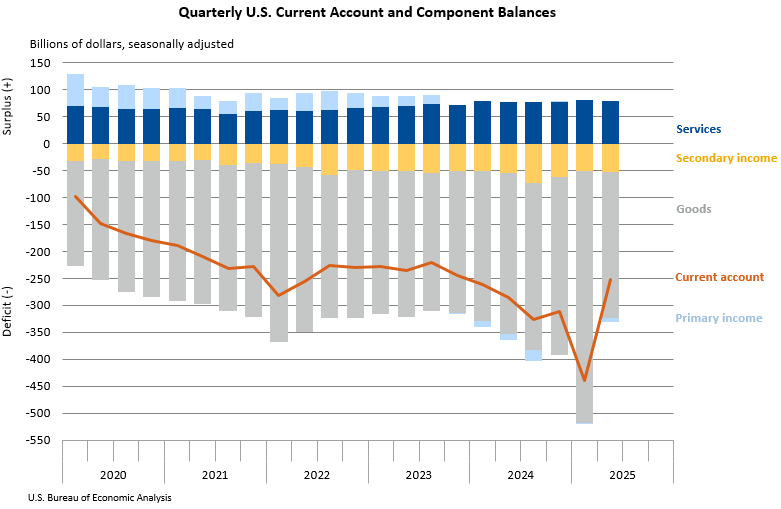Bureau of Economic Analysis
U.S. International Transactions, 2nd Quarter 2025
The U.S. current-account deficit narrowed by $188.5 billion, or 42.9 percent, to $251.3 billion in the second quarter of 2025, according to statistics released today by BEA. The revised first-quarter deficit was $439.8 billion. The second-quarter deficit was 3.3 percent of current-dollar gross domestic product, down from 5.9 percent in the first quarter.
Principal Federal Economic Indicators
Noteworthy
The Latest
Northern Mariana Islands' Economy Grows in 2012, Shrinks in 2011
Newly published estimates for the Commonwealth of the Northern Mariana Islands show that real Gross Domestic Product, GDP adjusted to remove price changes, increased 5.2 percent in 2012 after decreasing 6.8 percent in 2011.
For comparison, real GDP for the United States (excluding the territories) increased 2.8 percent in 2012 and 1.8 percent in 2011.
Gross Domestic Product for the Commonwealth of the Northern Mariana Islands (CNMI), 2011-2012
This release is available as a PDF download.
Some Local Economic Statistics Eliminated Due to 2013 Budget Sequester
You probably noticed that today’s release of the Bureau of Economic Analysis’ (BEA) local area personal income statistics is missing some detail that’s normally included. Why?
Local Area Personal Income: Metropolitan Areas, 2001–2012
Personal income growth slowed in 2012 in most of the nation’s 381 metropolitan statistical areas (MSAs). Personal income growth slowed in 311 MSAs, accelerated in 65 MSAs, and remained unchanged in 5 MSAs. On average, MSA personal income rose 4.2 percent in 2012, after growing 6.0 percent in 2011. Personal income growth ranged from 12.1 percent in Midland, TX, to –1.6 percent in Yuma, AZ, one of only five MSAs where personal income declined…
Local Area Personal Income, 2001-2012 (benchmark estimate)
Personal income growth slowed in 2012 in most of the nations 381 metropolitan statistical areas (MSAs), according to estimates released today by the U.S. Bureau of Economic Analysis. Personal income growth slowed in 311 MSAs, accelerated in 65 MSAs, and remained unchanged in 5 MSAs. On average, MSA personal income rose 4.2 percent in 2012, after growing 6.0 percent in 2011. Personal income growth ranged from 12.1 percent in Midland, Texas to…
September 2013 Trade Gap is $41.8 Billion
The U.S. monthly international trade deficit increased in September 2013 according to the U.S. Bureau of Economic Analysis and the U.S. Census Bureau. The deficit increased from $38.7 billion in August (revised) to $41.8 billion in September as exports decreased and imports increased. The previously published August deficit was $38.8 billion. The goods deficit increased $3.0 billion from August to $61.3 billion in September; the services…
Personal Income Increases in September
Personal income rose 0.5 percent in September, the same as in August. Wages and salaries, the largest component of personal income, rose 0.4 percent after rising 0.5 percent. Farm proprietors’ income was boosted in September, reflecting the settlement of a class-action discrimination lawsuit against the U. S. Department of Agriculture.
Current-dollar disposable personal income (DPI), after-tax income, rose 0.5…
Personal Income and Outlays, September 2013
Personal income increased $67.4 billion, or 0.5 percent, and disposable personal income (DPI) increased $64.8 billion, or 0.5 percent, in September, according to the Bureau of Economic Analysis. Personal consumption expenditures (PCE) increased $24.7 billion, or 0.2 percent.
GDP Growth Picks Up in Third Quarter
Real gross domestic product (GDP) increased 2.8 percent in the third quarter of 2013, according to the “advance” estimate released by the Bureau of Economic Analysis. In the second quarter, the growth rate was 2.5 percent.
GDP growth The third-quarter growth reflected the following:




